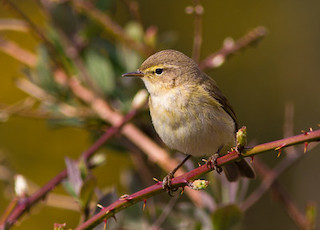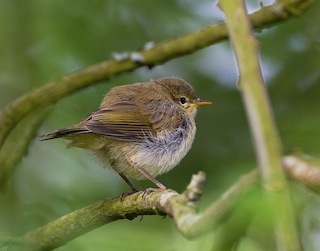 Mainly a summer visitor to the UK, a small but increasing number of this small warbler with its familiar song now overwinters here.
Mainly a summer visitor to the UK, a small but increasing number of this small warbler with its familiar song now overwinters here.
Photo: © Natural England/Allan Drewitt
Scientific name: Phylloscopus collybita
Other common names: Common Chiffchaff
Cornish name: Lawenmelyn
Conservation status: UK Birds of Conservation Concern, Green; IUCN Red List, Least Concern
What to look for:
- Colouring and appearance: Olive-brown upperparts, paler underparts, creamy to yellow flanks, dark legs and bill, short primary feathers. Recently-fledged juveniles are browner, but moult into their adult plumage about ten weeks after fledging.
- Size: Similar size to a Blue Tit: 10 cm length, 18 cm wingspan.
- Where: Its overall breeding range covers northern Europe and Asia; birds overwinter in southern Europe and Asia and northern Africa. It is found in suitable tree-covered habitat across the UK, but is much more scarce in Scotland.
- Call and song: A very distinctive two-note song that gives it its common name. The call is a hweet note.
- Similar species: Willow warbler: the two species are very similar.
 Amongst the signs that winter has finally pushed autumn aside is the loss of the familiar Chiffchaff song, repeated over and over again in our woodlands and parks throughout the summer. This small migratory songbird is one of the last to leave us at the end of the autumn. It is however also one of the first to return here in the spring, almost as if it regrets its enforced departure and is hurrying back. In fact, a small but increasing number of Chiffchaffs now overwinter in the UK (up to 1,000 birds of the 1.2 million pairs that breed here). So, keep an ear out from under your muffler on a winter’s day and you might still be lucky enough to hear one – an early reminder that spring will be back again.
Amongst the signs that winter has finally pushed autumn aside is the loss of the familiar Chiffchaff song, repeated over and over again in our woodlands and parks throughout the summer. This small migratory songbird is one of the last to leave us at the end of the autumn. It is however also one of the first to return here in the spring, almost as if it regrets its enforced departure and is hurrying back. In fact, a small but increasing number of Chiffchaffs now overwinter in the UK (up to 1,000 birds of the 1.2 million pairs that breed here). So, keep an ear out from under your muffler on a winter’s day and you might still be lucky enough to hear one – an early reminder that spring will be back again.
While the song of the Chiffchaff is instantly recognisable, it can be hard to catch a close sight of the bird itself as it flits between tree branches, flicking its wings and tail as it searches for its food of small invertebrates by foraging high in the tree canopy.
 It is the males that return first in early spring – some two to three weeks before the females – in order to begin the task of establishing a territory and getting ready to attract a mate. Each male aggressively defends his territory, which can be up to 20 m wide, throughput the breeding season. Despite its small size, it has been known to take on Stoats and Jays to protect the nest.
It is the males that return first in early spring – some two to three weeks before the females – in order to begin the task of establishing a territory and getting ready to attract a mate. Each male aggressively defends his territory, which can be up to 20 m wide, throughput the breeding season. Despite its small size, it has been known to take on Stoats and Jays to protect the nest.
Given that the Chiffchaff likes to forage and sing from high in the tree canopy, it is interesting to discover that it nests on or close to the ground. The female builds a feather-lined domed nest in bushes or amongst tall grass. She lays two clutches of five to six eggs (one clutch in the north of the range). The young fledge about two weeks after hatching, but remain close to and roost with the female for a further three to four weeks. The female takes on all the parental care duties of incubating and feeding.
Did you know…?
…Tongue twister: listen carefully to the Chiffchaff’s song, and you may occasionally hear it tripping over its own tongue and going Chaff-chiff.
…High-rise: Chiffchaffs only sing when they are sitting in a tree at over 5 m above the ground.
More information and references:
Svensson, L., Mullarney, K., Zetterstrom, D.,1986. Collins Bird Guide, second edition (translated by Christie, D., Svensson, L.). HarperCollins, London.
Published: November 2014
Author: Amanda Scott
Photos: © Natural England/Allan Drewitt
